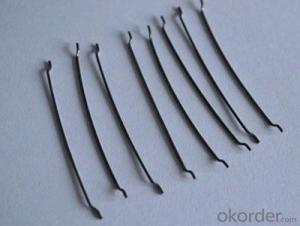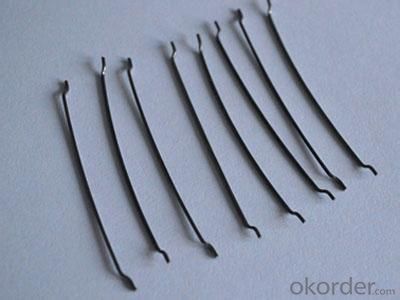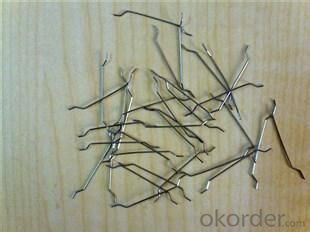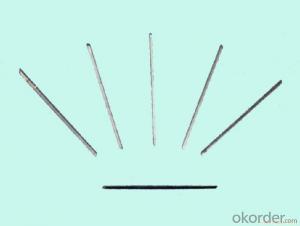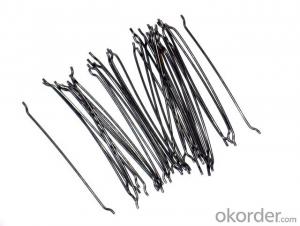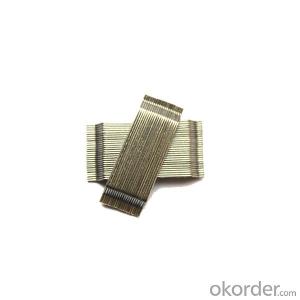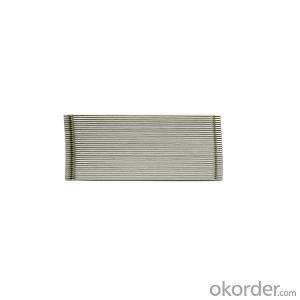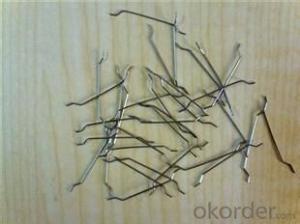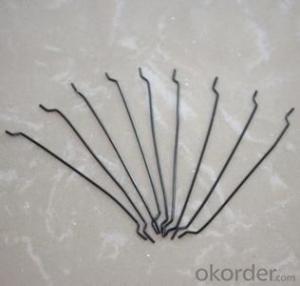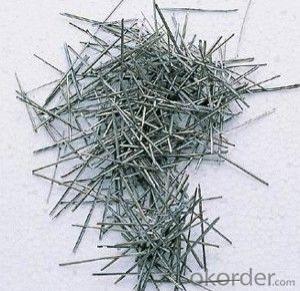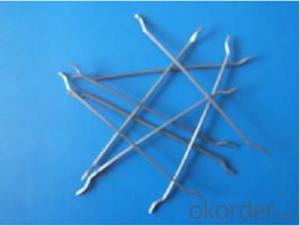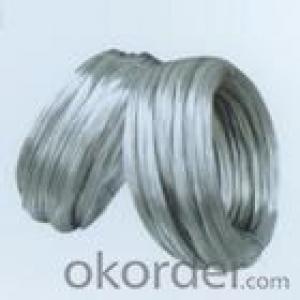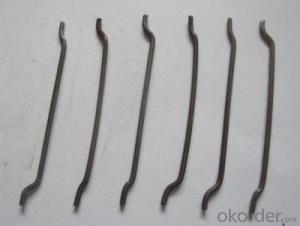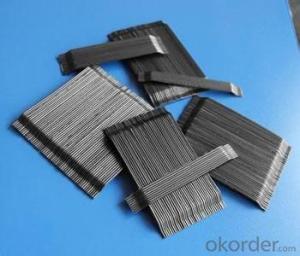Melt Extract Stainless Steel Fiber 0.55/30 Concrete Steel Fiber from CNBM China
- Loading Port:
- Tianjin
- Payment Terms:
- TT OR LC
- Min Order Qty:
- 1 m.t.
- Supply Capability:
- 5000 m.t./month
OKorder Service Pledge
Quality Product, Order Online Tracking, Timely Delivery
OKorder Financial Service
Credit Rating, Credit Services, Credit Purchasing
You Might Also Like
Quick Details
Place of Origin: Tianjin, China (Mainland)
Brand Name: Hengfeng
Model Number: 0.55
Material: Steel
Production Process: Cold drawn
Lengh: 30
Type: 1
Compressive Strength: >1200MPa
Aspect ratio: 55
Standard: ASTM A820M-11
Section Shape: Circular
Application: Concrete Reinforcement
Producing Area: Tianjin
Packaging & Delivery
| Packaging Details: | 20 kg/Bag,50 bags/Pallet or 1,000kg/ Bulk Bag |
|---|---|
| Delivery Detail: | 1 Month |
Product Description
| Diameter | 0.55 | mm | 0.02 | in |
| Length | 30.00 | mm | 1.18 | in |
| Aspect Ratio | 55 | |||
| Tensile strength | 1200 MPa | |||
| Type | Cold drawn Steel Fiber | |||
| End | Hooked-end Steel Fiber | |||
| Glued/Loose | Glued Steel Fiber | |||
| Bending Angle | 45°(min.30°) | |||
| Usage & Performance | Floor:Trafficked areas and Industrial floors | |||
| Shotcrete :Slope stabilization and Final lining | ||||
| Precast concrete:Pipe and Railway sleepers | ||||
| Packing | Standard Export Pallet Packing | Bag Packing | 20 kg/Bag,50 bags/Pallet | |
| Bulk Packing | 1,000kg/ Bulk Bag | |||
| Loading Quantity | 20’GP | 20-25 Tonne/Tonnes | ||
| 40’GP | 25-27 Tonne/Tonnes | |||
| 40’HQ | 25-27 Tonne/Tonnes | |||
| MOQ | 1 kg for trial order | |||
| Supply Ability | 10,000 Tonne/Tonnes per Year | |||
| Payment Terms | T/T or L/C at sight | |||
| Delivery Time | Within 15 days after receiving deposit or original L/C at sight | |||
| Certification | ISO9001:2000, CE, | |||

| Product | Diameter | Length mm/in | Aspect Ratio | Type | Packing |
| G-6030 | 0.5 mm (0.0197 in) | 30 mm (1.1811 in) | 60 | Glued | 20 kg/Bag, or 1,000kg/ Bulk Bag |
| G-6535 | 0.55 mm (0.0217 in) | 35 mm (1.3780 in) | 65 | Glued | 20 kg/Bag, or 1,000kg/ Bulk Bag |
| G-6035 | 0.6 mm (0.0236 in) | 35 mm (1.3780 in) | 60 | Glued | 20 kg/Bag, or 1,000kg/ Bulk Bag |
| G-8060 | 0.75 mm (0.0295 in) | 60 mm (2.3622 in) | 80 | Glued | 20 kg/Bag, 50 bags/Pallet |
| G-6060 | 0.9 mm (0.0354 in) | 60 mm (2.3622 in) | 60 | Glued | 20 kg/Bag, 50 bags/Pallet |
| G-6030 | 0.5 mm (0.0197 in) | 30 mm (1.1811 in) | 60 | Loose | 20 kg/Bag, or 1,000kg/ Bulk Bag |
| G-6535 | 0.55 mm (0.0217 in) | 35 mm (1.3780 in) | 65 | Loose | 20 kg/Bag, or 1,000kg/ Bulk Bag |
| G-6035 | 0.6 mm (0.0236 in) | 35 mm (1.3780 in) | 60 | Loose | 20 kg/Bag, or 1,000kg/ Bulk Bag |
| G-8060 | 0.75 mm (0.0295 in) | 60 mm (2.3622 in) | 80 | Loose | 20 kg/Bag, 50 bags/Pallet |
| G-6060 | 0.9 mm (0.0354 in) | 60 mm (2.3622 in) | 60 | Loose | 20 kg/Bag, 50 bags/Pallet |
- Q: What is the effect of melt extract stainless steel fiber on the flexural strength of concrete?
- The melt extract stainless steel fiber improves the flexural strength of concrete by enhancing its tensile and flexural properties. The addition of these fibers helps to control cracking and increase the overall durability and toughness of the concrete, making it more resistant to bending and flexing forces.
- Q: Does melt extract stainless steel fiber improve the resistance to freeze-thaw cycles of concrete?
- Yes, melt extract stainless steel fiber does improve the resistance to freeze-thaw cycles of concrete. The addition of stainless steel fibers in concrete helps to enhance its durability and performance by minimizing the detrimental effects of freeze-thaw cycles. When water freezes within the concrete, it expands and exerts pressure on the surrounding matrix, leading to cracking and eventual deterioration of the structure. However, the inclusion of melt extract stainless steel fibers helps to mitigate these issues. The fibers act as reinforcement within the concrete, providing additional strength and preventing the propagation of cracks. This reinforcement effectively enhances the resistance of the concrete to the damaging effects of freeze-thaw cycles. Moreover, melt extract stainless steel fibers have excellent corrosion resistance properties, which further contribute to the improved durability of the concrete. Unlike other types of fibers, stainless steel fibers do not corrode or degrade over time, ensuring their long-term effectiveness in enhancing freeze-thaw resistance. Overall, the addition of melt extract stainless steel fiber in concrete significantly improves its resistance to freeze-thaw cycles, preventing cracking and extending the lifespan of the structure.
- Q: How does melt extract stainless steel fiber improve the impact resistance of bridge decks?
- Melt extract stainless steel fiber is a promising material that can significantly improve the impact resistance of bridge decks. This fiber is manufactured by melting stainless steel and then extracting it into fibers of various lengths and diameters. These fibers are then mixed into the concrete matrix during the construction of bridge decks. The addition of melt extract stainless steel fiber to bridge decks brings several benefits that enhance their impact resistance. Firstly, the fibers act as reinforcement within the concrete, creating a three-dimensional network that increases the tensile strength and overall durability of the structure. This reinforcement effectively distributes the load and impact forces, preventing cracks and fractures from propagating and compromising the integrity of the bridge deck. Moreover, the unique properties of stainless steel, such as its high strength, corrosion resistance, and ductility, make it an ideal material for improving the impact resistance of bridge decks. When subjected to impact or dynamic loading, the stainless steel fibers absorb energy and dissipate it throughout the concrete matrix, reducing the stress concentration and minimizing the risk of damage. This energy absorption mechanism helps bridge decks withstand heavy traffic, seismic events, and other external impacts. Additionally, melt extract stainless steel fibers enhance the crack resistance of bridge decks. The presence of these fibers inhibits crack formation and propagation, as they act as micro-reinforcements that bridge small cracks and prevent them from expanding. This crack bridging effect not only improves the overall durability of the bridge deck but also minimizes maintenance needs and extends the service life of the structure. In conclusion, melt extract stainless steel fiber is a valuable addition to bridge deck construction, as it significantly improves impact resistance. By reinforcing the concrete matrix, absorbing and dissipating energy, and enhancing crack resistance, this material ensures the longevity and structural integrity of bridge decks, making them more resilient to various types of impacts.
- Q: What is the recommended mix design for concrete containing melt extract stainless steel fiber?
- When incorporating melt extract stainless steel fiber into concrete, it is advised to use a larger amount of fibers compared to traditional mix designs. This is due to the higher aspect ratio and superior tensile strength of stainless steel fibers, which enhance reinforcement and crack resistance in the concrete. The specific fiber dosage may vary depending on the intended application and desired performance characteristics of the concrete. However, a general recommendation is to use between 1% and 2% of stainless steel fibers by volume. This dosage range has been proven to offer optimal reinforcement and enhance the overall durability of the concrete. In addition to the fiber dosage, it is crucial to take into account other factors such as the water-cement ratio, aggregate gradation, and selection of admixtures. The water-cement ratio should be meticulously controlled to ensure a workable mix with sufficient strength. The aggregate gradation should be optimized to achieve a compact and robust concrete matrix. Furthermore, admixtures can be employed to improve workability, pumpability, and setting time of the concrete. To determine the specific mix design parameters for a project involving melt extract stainless steel fiber, it is advisable to consult with a qualified engineer or concrete supplier. In summary, the recommended mix design for concrete containing melt extract stainless steel fiber involves a higher fiber dosage, careful control of the water-cement ratio, optimization of aggregate gradation, and appropriate use of admixtures. By following these guidelines, a high-performance concrete with enhanced reinforcement and durability properties can be achieved.
- Q: Can melt extract stainless steel fiber be used in tunnel shotcrete applications?
- Certainly, tunnel shotcrete applications can utilize melt extract stainless steel fiber. Shotcrete mixes commonly incorporate stainless steel fibers to enhance the overall performance and durability of the concrete. By introducing stainless steel fibers, the shotcrete's tensile strength, impact resistance, and crack resistance can be improved, making it suitable for tunnel scenarios where the concrete must endure high pressures, vibrations, and potential ground movements. Notably, melt extract stainless steel fibers offer several advantages, such as high tensile strength, corrosion resistance, and uniform dispersion throughout the shotcrete mix. Consequently, the shotcrete benefits from consistent reinforcement and can effectively withstand the rigorous tunnel environment. All in all, melt extract stainless steel fiber serves as a dependable and efficient choice for reinforcing shotcrete in tunnel applications.
- Q: Can melt extract stainless steel fiber reduce the risk of early-age cracking in concrete?
- The inclusion of melt extract stainless steel fibers in the concrete mix can effectively mitigate the occurrence of early-age cracking. Shrinkage, temperature fluctuations, and insufficient tensile strength are common factors contributing to such cracking. The addition of these fibers enhances the overall tensile strength of the concrete, acting as a reinforcement that effectively disperses stresses and hinders the initiation and spread of cracks. Furthermore, these stainless steel fibers aid in controlling concrete shrinkage by diminishing the size of cracks, both in width and length. This subsequently minimizes the risk of early-age cracking and enhances the longevity and durability of the concrete structure.
- Q: What is the recommended fiber dosage when using melt extract stainless steel fiber in shotcrete?
- The recommended fiber dosage when using melt extract stainless steel fiber in shotcrete typically ranges from 25 to 40 kg/m3, depending on the specific requirements of the project and the desired performance characteristics.
- Q: What is the diameter range of melt extract stainless steel fiber?
- Typically, melt extract stainless steel fibers have a diameter range of 5 to 50 micrometers.
- Q: Can melt extract stainless steel fiber be used in lightweight aggregate concrete wall panels?
- Yes, melt extract stainless steel fiber can be used in lightweight aggregate concrete wall panels. Stainless steel fibers are commonly used as reinforcement in concrete to improve its strength, durability, and resistance to cracking. The lightweight nature of the aggregate in the concrete panels makes them suitable for various applications, including wall panels, where the addition of stainless steel fibers can further enhance their mechanical properties.
- Q: Can melt extract stainless steel fiber be used in architectural facades or cladding systems?
- Melt extract stainless steel fiber is an ideal choice for architectural facades or cladding systems. Its purpose is to reinforce concrete and other construction materials, ensuring their durability and strength. By integrating this fiber into the facade or cladding system, its structural integrity and ability to resist cracking or deformation are significantly improved. Moreover, due to its remarkable resistance to corrosion, it is perfectly suitable for outdoor applications, even under diverse weather conditions. With its versatility and capacity to enhance the performance of architectural elements, melt extract stainless steel fiber emerges as a practical and feasible option for architectural facades or cladding systems.
Send your message to us
Melt Extract Stainless Steel Fiber 0.55/30 Concrete Steel Fiber from CNBM China
- Loading Port:
- Tianjin
- Payment Terms:
- TT OR LC
- Min Order Qty:
- 1 m.t.
- Supply Capability:
- 5000 m.t./month
OKorder Service Pledge
Quality Product, Order Online Tracking, Timely Delivery
OKorder Financial Service
Credit Rating, Credit Services, Credit Purchasing
Similar products
Hot products
Hot Searches
Related keywords
